"Will your construction project be successful for all participants?" Many construction projects are unsuccessful. (Based on a study by KPMG last year only 31% of respondents’ projects over the previous three years came in within 10% of their budgeted cost and only one quarter of projects over that period came in within 10% of their original deadlines.) This judgement is based solely on the fact that they were finished over budget or late. But even when construction projects are finished within budget and on time are they necessarily a success? Well, that answer often depends on your association to the construction project! Let’ ask these questions about construction projects
Indeed, there is the opposite, where some of the most disastrous construction projects have turned out to be hugely successful. Consider the Sydney Opera House – named in the Hall of Shame of landmark building projects with major cost blowouts (the project was completed 14 times over budget and 10 years late), yet today the Sydney Opera House now stands as a city icon (even a national icon) recognised worldwide, a mega tourist attraction and successful venue. Are your subcontractors profitable? Should you care? "Do you know who the stakeholders on your construction project are?" Construction project stakeholdersEvery construction project has many stakeholders which include:
Each of these stakeholders often has competing demands that can jeopardise the success of a construction project. We want a win-win for all stakeholders involved with a construction project. Is this possible? Does the client have to get the construction project delivered under-budget at the expense of the contractor? Does the contractor only make a profit at the expense of their subcontractors and their workers? Does the community want a cheap project that is a blight on the neighbourhood? Is the design team interested in the long-term maintenance of the facility? Dealing with the different construction project stakeholdersUnfortunately, often all of the stakeholders aren’t considered, while in other cases some stakeholders are allowed to dominate the process at the expense of others. In some instances personal interests and egos are allowed to dictate the project. Running through all of this is money – everyone wants the cheapest price and the most profit. There needs to be honest dialogue with the various stakeholders to ensure the best outcomes for all parties and the project. They might not be the desired outcomes at the start of the process, but the outcome should be best result for all parties after due compromises have been made. The Importance of Stakeholder Management in Project Success "Will all those on your construction project be happy with the final project?" What defines a successful construction projectA successful construction project is one which:
Why Safety Is Important On Your Construction Project How important is quality on your project? Delivering a successful construction projectIs it possible for a construction project to tick all the boxes and be successful in every respect? Good construction project management with open and honest dialogue and a team that is focused on the project and not on individuals and companies is surely a good start. One stakeholder’s success shouldn’t depend on another’s failure. What do you think? Have you delivered a truly successful project? What disastrous projects have you been involved with? Why many government construction projects aren't successful Please share this post To read more about the author’s books and find out where you can purchase them visit the pages on this website by clicking the links below:
'Successful Construction Project Management: The Practical Guide' 'Building a Successful Construction Company: The Practical Guide' 'Construction Book reviews' To read more about the author visit the page 'Paul Netscher' Want to contact Paul Netscher please enter your details on 'Contacts' Find out how Paul Netscher can help you Order your books from Amazon Order your books from Amazon UK © 2016 and © 2023 This article is not to be reproduced for commercial purposes without written permission from the author.
1 Comment
Making money on construction projects should not be about luck, it requires planning, doing the basics right, and looking out for every dollar." Construction is a tough industry and many construction companies are facing difficult times. Yet there are always some contractors that are growing and increasing their profits. How do they do it? Are they lucky? Construction shouldn’t be about luck. Sure we sometimes appear to have construction projects that appear to be luckier than others – projects where the sun seems to literally shine. However, managers of successful projects and companies create their own luck. They get the basics right. "My book ‘Building a Successful Construction Company: The Practical guide’ focusses on improving profits in construction companies." 10 tips to improve profits on construction projects Here are 10 tips to help your construction company grow profits and avoid construction projects lose money. 1. Price your construction projects correctly – This includes reading the pricing documents carefully and understanding what’s in your scope of work. Check that you can deliver the construction project safely and to the required quality in the time the customer demands. Don’t commit to a construction project when you don’t have the necessary resources or skills to construct it, or one that has an impossible duration. Rather, price a few chosen projects carefully, and don’t use the ‘shot gun’ approach of pricing as many projects as possible hoping you’ll win one. Visit the project site to ensure you have allowed for any problems or obstacles that may be encountered during construction. Understand the project risks and ensure they can be managed or are allowed. Develop new strategies of how you’ll win the construction project and deliver it successfully and profitably Don’t make a mistake when you price your next construction project. 2. Reduce wastage on your construction projects – There always seem to be inordinate amounts of waste materials hauled on construction project sites. Not only are there the original costs of the building material but then there are the costs of loading, hauling and dumping the waste – and dumping costs are increasing every year. Some of this construction waste is generated by poor quality work and construction errors which results in completed work being demolished and redone. Some waste is generated by poor handling of construction materials resulting in breakages. Often though, project teams over-order materials, order the wrong material, or don’t optimise the size of materials resulting in excessively large off-cuts and wastage. When you order construction materials take some time to ensure the quantities are correct, they’ll be packaged and transported in such a way to minimise breakages and so they’re effortlessly off-loaded at the project, and that you’ve ordered the size that will easily be handled and have the least amount of cutting and waste. Construction Debris Waste or Sustainable Commodity? "Wasted construction materials is like throwing your money away." 3. Improve productivity – Construction projects are notoriously for low productivities. I’m sure we’ve all witnessed people and machines standing idle on construction projects. Poor productivity can be due to a number of problems including:
4. Ensure you claim for work completed – I cannot believe how many contractors don’t claim for additional work they’ve done or don’t claim for items that the client was obligated to supply but didn’t. Part of this is because the contractor’s manager hasn’t read the contract, hasn’t looked at what was priced, or isn’t aware of what work has been performed on the project. Sometimes it’s because the project manager is of the mistaken belief that the client will be upset by a claim for additional works or delays. Are you working for free on your construction project? "Construction Claims a short guide for contractors is an essential book for project managers and will help you prepare and win your next variation claims and change order." 5. Finish your construction projects on schedule – When I mean finish, I mean 100% complete with all documentation handed-over and all snag lists (punch lists) completed. All too often I encounter contractors still working on projects long after they should have been completed. To ensure the construction project is completed on time use a properly prepared construction schedule which is regularly referred to and updated. Ensure the construction team understands the schedule. Complete documentation and punch listing as the project progresses so these items aren’t left to the end.The Secret to Finishing Construction Projects On Time 6. Negotiate with suppliers – Negotiate with your suppliers and subcontractors to get the best rates and payment terms. Ensure that they are paid on time so that payment discounts can be claimed. Always get more than one quote, preferably three, so you can check the prices you’ve received are competitive. Managing your subcontractors. Ensuring your project is successful. 7. Ensure your invoices are paid on time – this entails submitting your invoices in the correct format, on time and to the correct person. Some clients only run payments at a specific day in the week, or the month, so even submitting invoices a day late could delay payment by a week or more. Even more important is to ensure your client pays you on time. Some clients make a habit of paying invoices late. Every month there’s a different excuse. Make sure you track your payments through the client’s system to ensure there aren’t any delays. Negative cash flow – the death for many construction companies 8. Claim deposits back – many construction projects are completed and the contractor fails to claim their deposits back. These deposits could include for utility connections, office or house leases, or perhaps a deposit to the local council as a bond in case your project damages the road or sidewalk and you don’t repair it. Each construction project should have a schedule of the deposits paid so these can be tracked and claimed back. When paying suppliers ensure that previous monies paid as deposits or advances are deducted from the final monies due. 9. Get paid retention monies and have bonds returned as soon as possible – Completing your project on time enables you to claim back retention monies and recover bonds as soon as possible. Sometimes the project team moves onto their next construction project and forgets to claim these back, which costs the company money. Maintain a schedule of all outstanding retention monies and bonds so they are tracked and returned. 10. Consider alternative materials and construction methods – there are new construction materials on the market that could be cheaper, easier to install or provide better durability. Of course, check first that these meet specifications and codes. Consider alternative construction techniques. Using precast or modular elements could speed up construction. New technology is appearing all over in construction and some systems can simplify construction and managing our projects. Get smart! You can make your construction company profitableMinor changes to the way you operate can make your construction company and your construction projects more profitable. Operating smarter will allow you to be more competitive, leading you to win more construction projects. Some contractors are making big profits, why not become one of them. Call in an expert to improve the way you operate. Ensure your construction managers understand how every cent is important. But ensure you are making real savings and not throwing money away or doing things that will negatively impact the project's safety or quality, or cause delays to the project, or spoil your company's reputation and relationship with your client. Don't save construction costs by doing this This article was first published on the ClockShark website - Get The Industries' #1 Time-Tracking AppRunning a field service or construction business takes coordination and a great team. With ClockShark you get the industries' #1 timesheet ap Learn more about Construction Project Management"The book is very helpful for the issues of managing a construction company. On most cases, it deals directly to the main point and gives the ideal solutions. I felt sorry for not reading this book at the start of my managing career." To read more about the author’s books and find out where you can purchase them visit the pages on this website by clicking the links below:
'Successful Construction Project Management: The Practical Guide' 'Building a Successful Construction Company: The Practical Guide' 'Construction Book reviews' To read more about the author visit the page 'Paul Netscher' Want to contact Paul Netscher please enter your details on 'Contacts' Find out how Paul Netscher can help you Order your books from Amazon Order your books from Amazon UK © 2016 This article is not to be reproduced for commercial purposes without written permission from the author. "Is your construction project healthy or is a cancer eating your profits?" This last week I’ve had a cold which has made me feel tired and I have to constantly stop what I’m doing to blow my nose. This has impacted my work making me less efficient and leading to mistakes. Just as our performance suffers when we are ill our construction projects can suffer when they’re ill, or when they aren’t running as well as they should. Do you know if your construction project is healthy, or is there a cancer that’s slowly eating your profits and impacting progress? Construction project health testsWe are encouraged to undergo regular health check-ups. In the same way our construction projects undergo health check-ups. These may include:
The problem with most health checks is that they aren’t always reliable. They also sometimes detect the problem when it’s too late or the problem is already large. Of course some problems are misdiagnosed or the wrong treatment is prescribed. Then there are many who choose to ignore the warning signs and carry on as normal. Don't make these 10 mistakes with your cost reports "Do not ignore the warning signs when your construction project is in trouble" How to detect problems in construction projects earlyUnfortunately, many construction project managers try to manage their projects from the office, relying on meetings, emails and reports to monitor their construction project. However, there’s nothing that beats actually walking the project, being in the field and interacting with your team. When you do these walks, it’s usually obvious when the project isn’t healthy. Is the project neat and organized, or is it chaotic? Is everyone busy or are some standing around underutilized? Is all the equipment being efficiently used? Does there appear to be a plan in place? When I walk around my construction projects I constantly look for 3 things:
But it’s also important to talk to your construction team. Observe how they interact with each other. Are they working as a team? Are they motivated to produce quality work, safely and as productively as possible? Do they have the right skills and equipment? Is morale good? Happy workers will be more productive than those who are simply waiting for the next pay-day. As I walk around the field I also ask the following questions:
If the answer to any of these questions is no, there may be reasons to lodge a Variation Claim. Have you talked to your customer recently? What do they think of the project’s progress and quality? You may be surprised at what they have to say – but hopefully not disappointed! But they will almost certainly appreciate the opportunity to share their thoughts. Does your company actively promote the reporting of problems? Know when there are problems on your construction projects"Is your construction project performing like a well-trained and fit sports team or is it wheezing?" Is your construction project performing like a well-trained and fit sports team or is it wheezing like a group of old men who’ve just climbed a flight of stairs? Is your project healthy, or are you waiting to assess those health checks at the end of the month? What will those health checks tell you, and will you know how to react to any bad news? Being in the field enables you to perform a quick health check on your construction project – kind of like taking its temperature and checking the pulse. Detecting an unhealthy construction project early may enable you to take early preventative action to prevent the problems becoming worse, or perhaps just simmering away, sapping the project’s energy every day. 10 Commandments for Construction Project Managers This article was first published on the ClockShark website - Get The Industries' #1 Time-Tracking AppRunning a field service or construction business takes coordination and a great team. With ClockShark you get the industries' #1 timesheet ap Learn more about Construction Project Management"A practical guide based on great experience of a real professional. If just only part of recommendations is followed by contractors the ratio of successful projects would grow dramatically." To read more about the author’s books and find out where you can purchase them visit the pages on this website by clicking the links below:
'Successful Construction Project Management: The Practical Guide' 'Building a Successful Construction Company: The Practical Guide' 'Construction Book reviews' To read more about the author visit the page 'Paul Netscher' Want to contact Paul Netscher please enter your details on 'Contacts' Find out how Paul Netscher can help you Order your books from Amazon Order your books from Amazon UK © 2016 This article is not to be reproduced for commercial purposes without written permission from the author. "Almost every construction project will have changes and delays. Contractors must understand the process to successfully claim for their costs and delays." On almost every one of the 120 plus construction projects I’ve been involved in we have encountered variations which have resulted in us submitting change order claims. Some were for extension of time due to delays caused by our client. Other claims were for increased scope of work, changes in the scope, new specifications or altered project conditions. Many of these claims were for millions of dollars and some projects almost doubled in value. Yet, in most cases we received the full value of our claim or the full extension of time requested. Furthermore we resolved 99% of the claims amicably without resorting to arbitration or legal processes, and we maintained a good relationship with our customers, almost always going on to complete other projects with them. So why were we so successful submitting construction change order claims and why do so many contractors’ change order claims end up not being accepted, or if they are it’s only after an expensive and time-consuming legal process? Know your client as they are vital to settling change order claims amicablyThe ease of settling a construction change order claim starts with your customer, your relationship with your customer and sometimes relates to their budget. Some customers are adversarial with their contractors and will dispute every change order submitted. Do you really want to work for these customers? It’s essential you understand your customer when bidding for a construction project. Don’t work for those who have a reputation for frequent legal disputes with their contractors. In construction it’s important to know your clients. It could save you. Having a good relationship with your customer is essential. If you are adversarial they will take the same approach. Continually talking to your customer keeps them informed so when change orders are submitted they aren’t taken by surprise. If customers think they can trust you and that generally you’re honest with them they’ll often be more receptive to your variation claim. However, if you have a habit of submitting spurious or inflated claims they’re likely to oppose your claims immediately. It helps if your customer has money in their budget to pay for change orders. Some clients have no funds to pay change orders and will do everything possible not to pay extra to their contractors. Try and ensure your customer remains within their budget and resist pricing projects where you know their budget is too tight. Understand your construction contractContractors often get into trouble because they sign and agree to construction contract conditions which offer them little protection. Before pricing a construction project ensure the terms and conditions of the contract are equitable and that the risks you have to take on are reasonable and manageable. The terms of some construction contracts may make it very difficult to submit a claim or the contract may confer the risk of many variations on the contractor, even when they have little control of these risks. Don’t start construction projects without a proper contract It’s essential you understand the contract document, that you are familiar with the scope, and know both your obligations and your customer’s. Claims need to be submitted in the time frames in the contract and risk being refused if they aren’t. An introduction to construction variation claims for construction project managers video 14 - The Construction Contract Document Presenting your construction change order claimI’ve seen many poorly put together change order requests. Some for millions of dollars, yet contractors often apply minimal time and effort to formulating their claims. Some even delegate their variation claim preparation to junior inexperienced quantity surveyors or contract administrators. Sometimes the construction project manager isn’t even aware a variation claim has been submitted and is blindsided when their client takes offence to a spurious or unsupported claim. Should construction project managers take the lead with variation claims? I’ve seen variation and delay claims with math errors, spelling mistakes (even incorrectly spelling the client’s name), factual errors, contradictory information, confusing language and unsupported evidence. Contractors should ensure that a knowledgeable and experienced person is allocated to draft the claim (familiar with the contract, the client and the work that’s been done) and that it’s reviewed and checked by the project manager before it’s submitted. It’s preferable to keep variation claims separate unless they are linked, and one impacts another. Combining different change orders and variation claims in the same submission can be confusing for the customer. Rejection of one claim could delay approval of the others. "Construction variation claims are usually worth lots of money so put the effort in to preparing a successful claim." What to include in your variation claimA properly drafted and well thought out construction change order claim will be hard for your client to refute and it’s likely to be successful. Claims should be clear, concise and logical. Successful change order claims should have:
As part of formulating the impact of the event all calculations and schedules should be included. The change order claim schedule should reference the approved contract construction schedule (construction programme). Calculations should reference where the facts and figures came from and how they were put together. The calculations should be checked for math errors (which can occur all too frequently). Remember to include all of your legitimate and claimable costs. It’s usually difficult to add in extra forgotten costs after you have submitted your claim. It’s unprofessional and will annoy your client. It may even cast doubts on the legitimacy of your original claim. Construction project variations – have you included all your costs? It’s useful to discuss your change order claim with others in the project construction team to ensure you have the facts set down correctly and that you have referenced the relevant documents and included all of the costs. Get someone to check your claim for errors and to see if they can follow your logic. If your logic is flawed, or can’t be easily followed your customer will be inclined to reject it first, before asking questions. Once a change order claim is rejected it becomes more difficult to change their mind and convince your customer you’re entitled to the variation. An introduction to construction variation claims video 16 - Documents required to support your claim "An easy-to-read book that will help you submit winning variation claims." Submitting your change order claimThe client must be notified of variations as soon as you become aware of them, and certainly within the time specified in the contract. Failure to do so may mean the contractor loses the right to claim. The variation claim must:
It’s often a good idea to discuss large or contentious variation claims with your client before submitting them. This not only forewarns the client the claim is coming, but also provides an opportunity to discuss the reasons and the merits of the variation. Successfully negotiating your change orderAs much as you may consider your variation claim as complete, final and non-negotiable, it’s almost certain that your customer will come back with questions, counterarguments and try and negotiate the quantum of the variation claim down, or even reject it completely. In responding to questions from the client ensure that your replies remain factual and stick to the original arguments presented in your claim. It’s easy to introduce other arguments and ideas which could be contradictory or confusing. Reply to all questions in writing referencing the original variation claim. If the questions are raised in a meeting take notes of the questions and your answers and confirm them afterwards in writing. It goes without saying that all correspondence relating to the variation claim and change order needs to be filed where it’s readily able to be retrieved. Some claims can take months to resolve, and if the claim follows the legal or arbitration route it could even take years. But even when a change order is approved it may still be subject to audit by a third party at the end of the project. Negotiating a construction variation claim – read this first to improve your success "Ensure all agreements are confirmed in writing." Ensure your construction variation claims are approvedIt’s essential variation claims are correctly formulated and submitted in accordance with the contract. They need to be resolved as soon as possible, preferably amicably and without resorting to protracted legal disputes. However, this shouldn’t mean that contractors don’t fight for their entitlements in terms of the contract. A properly drafted and presented variation claim which is fair will be more readily accepted by your customer. Make sure your variation claims and change orders are successful. 15 Rules for construction variation claims and change orders How do you ensure your variation claims are successful? This article was first published on the ClockShark website - Get The Industries' #1 Time-Tracking AppRunning a field service or construction business takes coordination and a great team. With ClockShark you get the industries' #1 timesheet ap Learn more about Construction Project Management"Most of the books on claims would focus on the ingredients of a claim, but very few indeed give practical advice on actual writing. This book fills this gap so nicely. It is well-structured and clearly written." To read more about the author’s books and find out where you can purchase them visit the pages on this website by clicking the links below:
'Successful Construction Project Management: The Practical Guide' 'Building a Successful Construction Company: The Practical Guide' 'Construction Book reviews' To read more about the author visit the page 'Paul Netscher' Want to contact Paul Netscher please enter your details on 'Contacts' Find out how Paul Netscher can help you Order your books from Amazon Order your books from Amazon UK © 2016 and © 2023 This article is not to be reproduced for commercial purposes without written permission from the author. 10 lessons for constructionBut watching the cyclists I’ve also realised that construction could learn from the race.
Successful construction projects are built by a good teamSo even if cycling isn’t your passion, it may be worth watching a few hours of the race, you never know what you could learn. Avid cycling fans now have an excuse for lazing on the couch watching the drama – at least you can say you are learning how to make your construction project more successful. But more seriously we can make our construction projects more successful with a great team, strong support, committed employees, good equipment, the right preparation, excellent planning, hard work, the right systems and honesty and integrity. The 10 P’s of successful construction project management What do you think it takes to make a construction project successful? Please share this post Learn more about Construction Project ManagementTo read more about the author’s books and find out where you can purchase them visit the pages on this website by clicking the links below: 'Successful Construction Project Management: The Practical Guide' 'Building a Successful Construction Company: The Practical Guide' 'Construction Book reviews' To read more about the author visit the page 'Paul Netscher' Want to contact Paul Netscher please enter your details on 'Contacts' Find out how Paul Netscher can help you Order your books from Amazon Order your books from Amazon UK © 2016 This article is not to be reproduced for commercial purposes without written permission from the author. Even if you are not a cycling fanatic, I'm sure you have sometimes watched the Tour de France cycling race on occasion. Every year for 3 weeks millions watch on television as about 200 cyclists ride 3000km through towns and the countryside and over some high mountains. Millions more line the roads to cheer on their cycling heroes or just to be part of the atmosphere. Now I’m not a cyclist but I do enjoy seeing the beautiful French scenery and stunning villages and chateaus unfold while cyclists from a host of nations battle up the hills and dodge screaming spectators.
"Are you making money on your construction project? Do you know?" I’ve always prepared monthly project cost reports for my construction projects. They’ve often been the fun part of the project where we’ve seen how well we’ve done that month on the project – how much profit we have made. Of course, there have been some construction projects where we’ve lost money, and these cost reports haven’t been quite as fun. These cost reports produced their own challenges as we tried to figure out where we were losing money and what we could do to recover the money and prevent further losses in the future. Construction project cost reports can provide a huge amount of valuable and useful information which can literally save projects, save companies, and save lots of money. But unfortunately, some cost reports are wholly inappropriate for the construction industry, others are done poorly, and a few take an inordinate amount of time to complete. Many don’t utilize the correct information - all of which can mean that the project team wastes their time producing misleading or useless data. In some cases, the data may be out of date by the time it’s produced while in other cases the data is simply ignored. "Is your cost report providing the right information for your construction project?" The good - how cost reports can help your construction projectMake sure your cost reports process is setup to help in the following ways:
"Don't work for free on your construction project. Learn how to submit and win variation claims and change orders." The bad - cost report mistakesUnfortunately, some cost reports can be complex and time consuming to prepare. Furthermore, contractors sometimes make errors in their cost reports which then provide bad data. Occasionally management ignores the cost report and doesn’t take action to figure out why the project is incurring losses, or they misinterpret what the cost report is showing. Some Project Managers leave the preparation and interpretation of the cost report entirely to their Estimators or Contract Administrators and pay little attention to the end report. They view it as just another document produced for their senior managers. The CONSTRUCTION project MANAGER'S financial duties You’ll likely find the following problems with costs reports:
"Does anyone look at your cost reports? Do you follow up to find why the project is losing money? The ugly in cost reports - lies, manipulation and moreBut even when the project team has all the correct information we can encounter ugly, dangerous problems:
Improving construction cost reporting
Construction cost reports are valuable when done properlyRegular construction project cost reports are invaluable and can provide much useful information. However cost reports with the incorrect information can give the project team a false sense of security. It’s essential that cost reports are kept relatively simple and also that companies have accounting systems which can quickly and easily provide accurate data to support the cost report. It’s important to investigate anomalies in cost reports. Don’t just take the report at face value. I’ve discussed investigating your losses, but sometimes it’s equally important to investigate where you are making money. You don’t want to find later that where you thought you were profitable you actually aren’t, and there were in fact errors with your report. Is your construction project losing money? Do you want to find out why? This article was first published on the Insightful Accountant website. Click the link to continue reading. Written by Paul Netscher Please share this post Learn more about Construction Project Management"Have read two of your books and their practical slant make them essential reading for any budding construction PM, they should be on academic reading lists rather than those dull theoretical PM texts kids are made to read! " To read more about the author’s books and find out where you can purchase them visit the pages on this website by clicking the links below:
'Successful Construction Project Management: The Practical Guide' 'Building a Successful Construction Company: The Practical Guide' 'Construction Book reviews' To read more about the author visit the page 'Paul Netscher' Want to contact Paul Netscher please enter your details on 'Contacts' Find out how Paul Netscher can help you Order your books from Amazon Order your books from Amazon UK © 2016 This article is not to be reproduced for commercial purposes without written permission from the author. "Are your workers tired? Would you notice if your team was suffering from fatigue? Is fatigue killing your project without you noticing?" Construction work is often strenuous, involves working long hours and working in difficult conditions – heat, rain, cold, dust and noise. Yet we expect our crews to deliver maximum productivity day after day, working tirelessly to meet the construction schedules we’ve committed to. Sometimes we forget that it’s people out in the field – not machines. But we rely on these people to produce quality work safely. As managers our jobs literally depend on our team delivering our construction projects on time. But, our workers may often suffer from fatigue. Why is there poor productivity on your construction project? How worker fatigue hurts construction projectsWorkers who are fatigued will negatively impact your construction project. Crews that are fatigued will:
"Accidents are often a result of fatigue, or even alcohol or drug consumption." Causes of fatigue in constructionFatigue can be due to a number of reasons:
"Working long hours on construction projects causes fatigue and lost productivity." How you can reduce worker fatigue on your construction projectTo reduce construction worker fatigue, the project should:
Are you suffering from fatigue?"Maybe you’re also suffering from fatigue which could be negatively impacting your work performance." What about your own work habits? Are you also in the habit of staying late at work? Maybe you’re also suffering from fatigue which could be negatively impacting your work performance – even negatively influencing your judgement and decisions? Maybe you don't even realise you are fatigued? Before you know it you're making mistakes at work, losing concentration while driving, or even worse you suffer sudden major health problems. Learn to delegate better. Organise your life better so you have fewer interruptions in the day and are able to get more done. The importance of effective delegation for successful projects Surprise your family and get home early today. Plan a weekend away – maybe even a holiday. You’ll be surprised how productive you can be after a break. Why is your construction project working long hours?Working lengthy shifts is often false economy. Not only are we paying workers penalty or overtime rates but productivity decreases exponentially after they exceed normal shift times. Sometimes working an extended shift is unavoidable – but then it needs to be limited to only the individuals who are necessary and shouldn’t be allowed to become the norm on the project. Is overtime crushing your construction project? A project that’s working extended shifts every day and working seven days a week normally indicates a project with a problem – often a project that hasn’t been planned properly. But don’t just consider the fatigue of your workers; consider also how fatigue is impacting your work, your life and your family. Time management This article was first published on the ClockShark website - Get The Industries' #1 Time-Tracking AppRunning a field service or construction business takes coordination and a great team. With ClockShark you get the industries' #1 timesheet ap Learn more about Construction Project Management"This is the best book on Project Management I have read." To read more about the author’s books and find out where you can purchase them visit the pages on this website by clicking the links below:
'Successful Construction Project Management: The Practical Guide' 'Building a Successful Construction Company: The Practical Guide' 'Construction Book reviews' To read more about the author visit the page 'Paul Netscher' Want to contact Paul Netscher please enter your details on 'Contacts' Find out how Paul Netscher can help you Order your books from Amazon Order your books from Amazon UK © 2016 This article is not to be reproduced for commercial purposes without written permission from the author. |
Archives
June 2024
Note: We welcome genuine comments, especially comments that add additional information to the subject matter in the article. We however reserve the right to remove inappropriate comments, which includes comments that have nothing to do with the subject, comments that include inappropriate language, and comments that are an advertisement for a product or company, or which include an advertising link. Comments must be in English. We will not enter into discussion on why a particular comment was removed.
CategoriesCopyright 2016 - The attached articles cannot be reproduced for commercial purposes without the consent of the author.
The opinions expressed in the attached articles are those of the writer. It should be noted that projects are varied and different laws and restrictions apply which depend on the location of the contractor and the project. It's important that the reader uses the supplied information taking cognisance of their particular circumstances. The writer assumes no responsibility or liability for any loss of any kind arising from the reader using the information or advice contained herein. "I have what I consider some of the best books on construction management."
Books are available from: Amazon.com Amazon.co.uk takealot.com kalahari.com Amazon.in Amazon.de Amazon.fr Amazon.it Amazon.com.au Powell's Fishpond uread bokus Amazon.ca Amazon.es Other retail stores Available in paperback or on Kindle "28 YEARS OF CONSTRUCTION PROJECT MANAGEMENT EXPERIENCE, DEVELOPING SUCCESSFUL CONSTRUCTION PROJECT MANAGERS AND BUILDING SUCCESSFUL CONSTRUCTION COMPANIES"
|


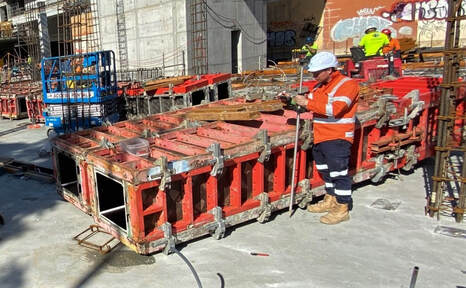
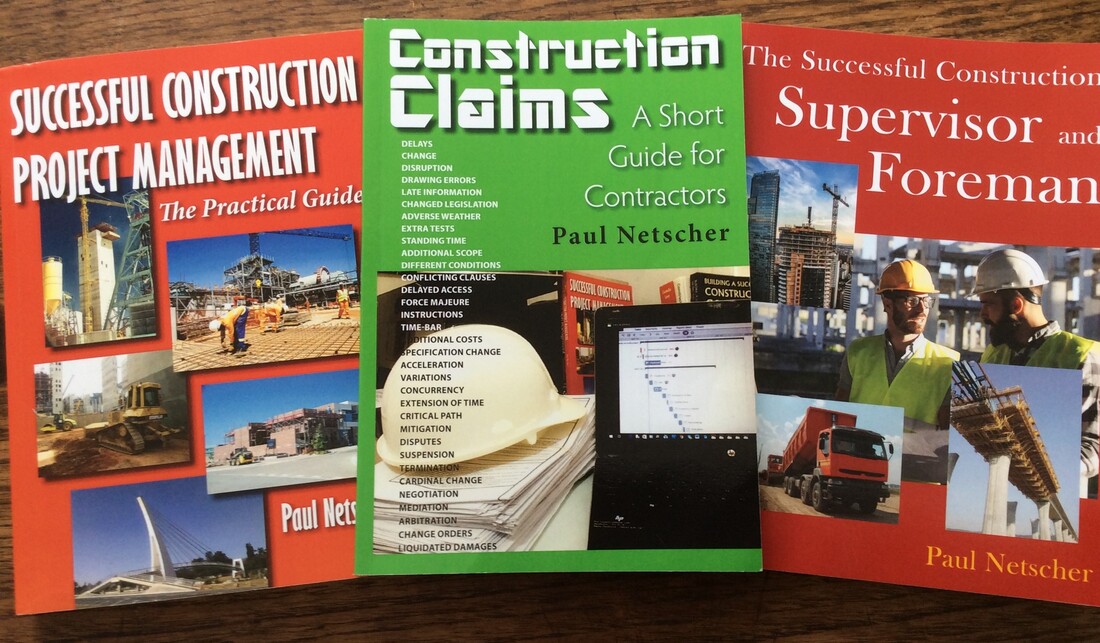






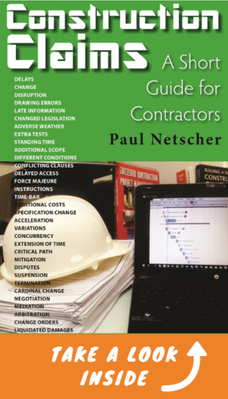
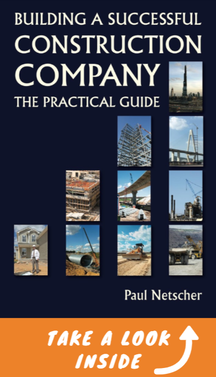



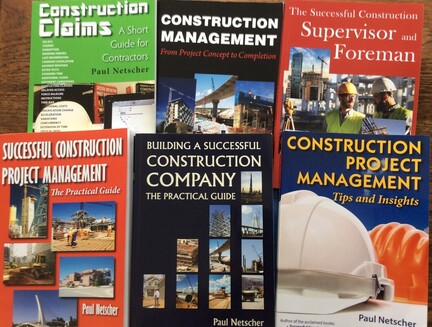
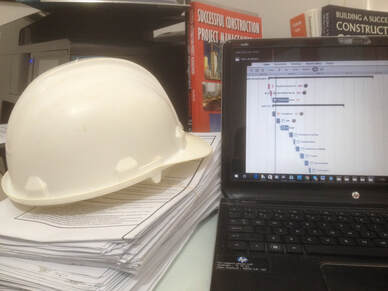




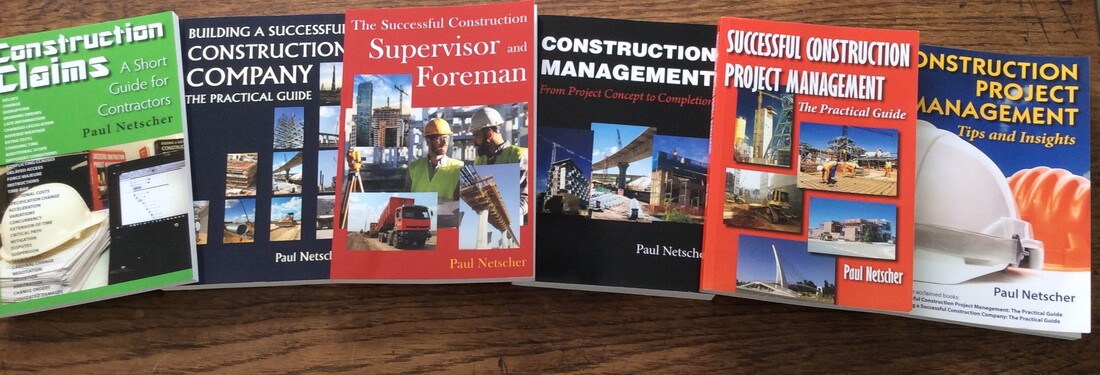














 RSS Feed
RSS Feed




